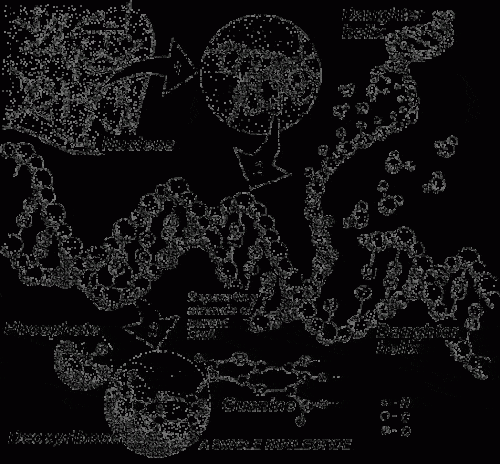Scientists attending the World Economic Forum in Davos in 2001 had no doubt that nanotechnology and biotechnology are expected to be the hot technology sectors in terms of their growth in the coming years, but many are also concerned about their social implications.

Lucas Van Greensven and Ben Hirschler
The combination of biology and microelectronics, which may make it possible to cure diseases and create babies on demand, will yield trillions of dollars in profits.
The scientists participating in the World Economic Forum here in Davos have no doubt that nanotechnology and biotechnology are expected to be the hottest technology sectors in terms of their growth in the coming years, but many are also concerned about their social consequences.
The reason for this is the completion of the mapping of the human genetic code, the genetic "recipe book" that has been broken down by scientists into a digital code that includes 3.1 billion chemical elements. Computer code, which takes the place of tissues under researchers' microscopes, has dramatically changed the way we perceive biology, said Bill Joy, chief scientist at Sun Microsystems, one of the world's leading computer manufacturers.
"It is very symbolic that the human genetic code was deciphered in the year 2000. In doing so, biology became a science centered on information," he said.
"The 21st century will be the age of real information, and I don't mean the Internet," Joy added. He estimated that the value of these new technologies could immeasurably overshadow those of the Internet age, which was once defined by venture capitalist John Doerr as the greatest legal accumulation of capital in human history. "The sky's the limit," Joy said. "During the next century they may generate profits that will reach up to 1,000 trillion dollars.
Baby shopping
The mapping of the human genetic code has opened up thousands of new possibilities for dealing with the causes of diseases, the most prominent of which is cancer, and scientists in the field of genetics believe that the day when it will be possible to apply genetic engineering to humans is not far off.
George Church, director of the Lipper Center for Genetics at Harvard Medical School, estimates that clinical doctors will soon be able to provide personalized treatment based on genetic mapping of the patient. "We should not rule out the possibility that in the not too distant future we will have technology that allows mapping the genetic codes of individuals," he said.
But there are also ethical questions. Presenting the question - would you like to map your children's genetic code, and eliminate "defective" genes even before they are born - to a group of politicians, scientists, computer engineers and entrepreneurs who participated in the meetings in Davos, yielded answers that were divided half and half.
But Jeremy Rifkin, president of the Foundation on Economic Trends, is sure that everyone would take advantage of the opportunity if it was given to them. "I guarantee you that everyone will want to map... a child will become the ultimate shopping experience in the post-modern lifestyle," he said.
New drugs for cancer
Richard Klausner, director of the US National Cancer Institute, said that there is a huge potential for improving the treatment of the disease, when the first fruits of research in the field of genetics are the discovery of new ways to differentiate between the dozens of existing cancer types. In 2001, biotechnology companies may focus their research on the body's natural healing abilities, using young cells that have been manipulated to produce almost all types of tissue that exist in the body.
"The era of using cells for these needs is in its infancy," said Irving Weissman, professor of pathology at Stanford University School of Medicine and founder of StemCells. His team has already succeeded in isolating cells that produce blood and transplanting them into cancer patients with the aim of restoring bone marrow damaged during radiation therapy.
"Wet" furrows versus "dry" furrows
However, breakthroughs are also recorded in fields outside of genetic code research, where treatment focuses on "wet" molecules (molecules), i.e. animals. Now the scientists are trying to produce "dry" furs. To create "dry" furrows, scientists use nanotechnology that aims to manipulate atoms, to enable the creation of furrows
"Intelligence". Xerox Labs is developing digital material that will stand on its own merits, said John Seeley Brown, Xerox's chief scientist.
While holding a small brown cube between his fingers, he said: "Our goal is to produce cubes of this type the size of a grain of sand. In the end they may become "dry" mares. When the speed of computers doubles every 18 months, the chips in 30 years may be a million times more powerful than today's chips. Tiny ferrets may one day be smart enough to sustain themselves and their environment.
"Ten years ago Nicolas Negroponti claimed that we would move from a world of atoms to a world of bits, but now we are moving in the direction of combining atoms and bits," said Seeley Brown.
Nathan Lewis, professor of chemistry and chemical engineering at the California Institute of Technology, said that the real impact of the study of the genetic code will be the ability to identify what actions proteins perform in the human body at any given moment. In this way, a person will not be required to wait for an increase in his body temperature to know that he is sick.
"Another possibility is self-sustaining materials. Implants that are in mutual relations with their environment without creating resistance in the body while perfectly integrating into the body," he said.
Paul Sappho, director of the American Institute for the Future, is thrilled by the combination of biotechnology and microelectronics: "It seems that the biggest surprise is the meeting between these two fields," he said.
